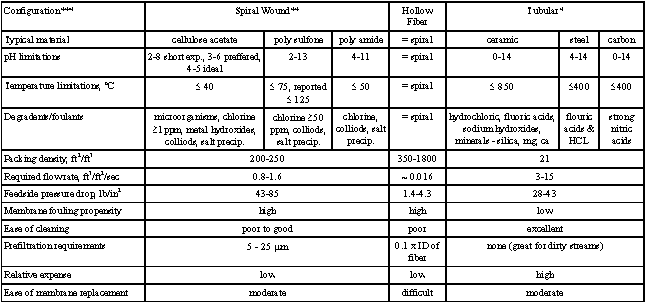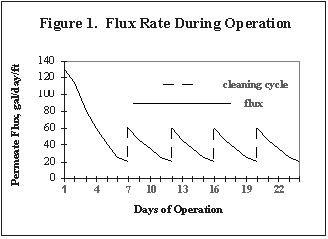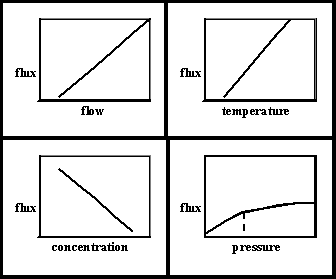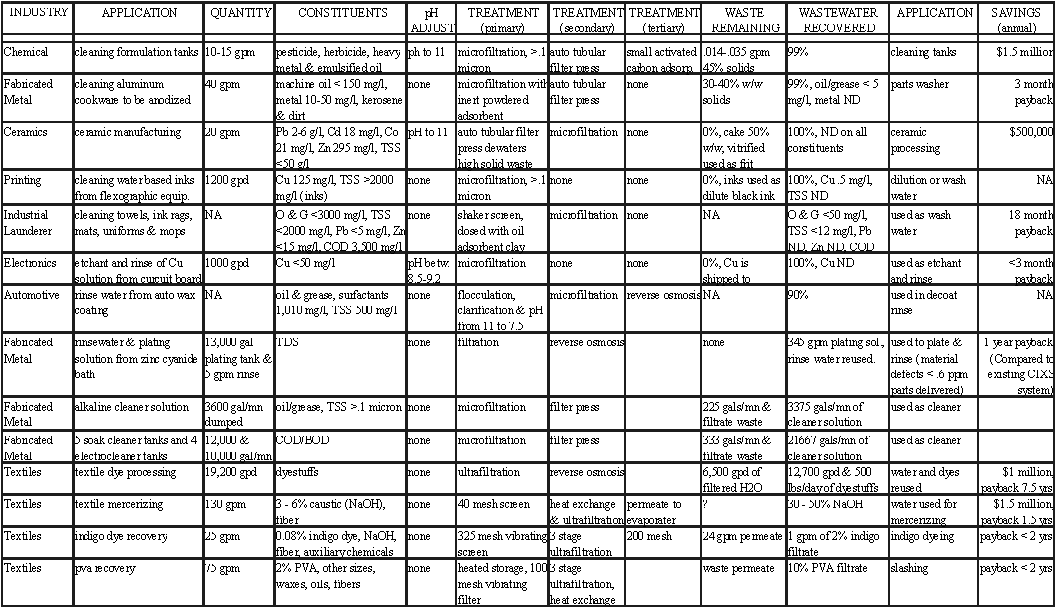

Edited 2/2/4/98 by Ronald Lee Still.
As advancements in membrane filtration technology become available, many facilities are finding it profitable to recover chemicals, product, and even water from wastewater that had been previously discharged to the sewer. Improvements in the design and decreasing costs of these systems have made possible a multitude of applications for this technology. Table 4 provides a summary of some industrial applications of membrane separation systems.
As facilities investigate new applications, it is important that they understand the limitations and requirements of the system to ensure proper application and operation. This fact sheet provides general information on types of membrane filtration systems and tips on purchasing and operating them.
This fact sheet targets membrane filtration systems used to filter contaminants ranging from 100,000 to 1 Å. Table 1 provides an overview of filtration terminology, the size of contaminants filtered, and required pressures.

Many of these filtration systems utilize a crossflow design that allows fluid to flow parallel to the membrane surface and helps to reduce contaminant build-up and fouling of the membrane.
In addition to the crossflow design, a variety of membrane filter configurations and media is used to improve filtration capabilities. Table 2 provides a listing of these configurations along with types of filter media and operating limitations and requirements.
As Table 2 shows, a variety of filter systems is available to recover resources, and each has advantages and disadvantages. Thus, it is important to identify the specific system that is most economical and appropriate for the project in question. Purchasers should follow the steps listed below to identify the system best suited for the project.
- Energy requirements: recirculating pumps, sensors, controllers, flux enhancement devices, etc.
- Prefiltration: frequency and costs of waste disposal and equipment.
- Filtration: frequency and costs of waste disposal, filter cleaning, and filter replacement.
- Labor and maintenance: fully or partially automated or totally manual.
- Product: value and volume of filtered material for reuse or resale.
- Efficiency: capability to maintain high flux rates with little care.

*Coating is typically titanium dioxide, zirconium dioxide, and/or an acrylic surface layer.
**Other materials not listed include polypropylene, polyethersulfone, polyvinylpyrrolidone, & PTFE.
*** Plate & Frame configurations were not included because of limited use on wastewater.
The vendor may charge a higher fee to provide these items, but the investment will usually pay for itself.
The greatest disadvantage to a filtration system is the problem associated with flux reduction (flux is the rate of filtration) and fouling. These factors can significantly increase the cost of operating a membrane filtration system unless preventative measures are taken.
| Figure 1 provides an example of the progress of the flux during the operation of a new membrane system.1 Initially, the system will have a relatively high flux that will quickly diminish as the membrane is fouled. Fouling occurs from colloidial flocculation or inorganic scaling above the membrane and adsorption of organics to the membrane.2 When the flux reaches a predetermined minimum rate, cleaning is required. The following agents are typically used for the foulants listed: |
 |
As shown in Figure 1, cleaning does not return the flux to the initial rate but to a value considerably lower. more frequent the cleaning, the lower the expected membrane life. Also, plugs of trace contaminants in the system can dramatically reduce membrane life.
Type of Foulant |
Cleaning Agents |
| Mineral Deposits/Precip. Salts |
Acids |
| Organic Foulants |
Alkalis |
| Micro-organisms |
Enzymes |
| Oils, Fat and Grease |
Detergents |
| All Foulants in Tubular System |
Sponge Balls |
Proper pretreatment is an economical and effective way to reduce cleaning frequency and membrane replacement. The following steps and technologies can assist in effective pretreatment:
| While pretreatment can help maintain flux and reduce fouling, other techniques can improve the flux of a membrane system. Figure 2, which shows the effects of pressure, flow, concentration of solution, and temperature on flux, indicates that increased flow, temperature, and pressure or decreased concentration can improve flux for a particular solution. It should be noted that increasing temperature reduces viscosity and that increased pressure effectively improves flux only to a certain point. Currently other technologies are being investigated that also improve and maintain flux bettr than conventional systems. Table 3 provides an overview of these technologies. |
Figure 2. Factors Affecting Flux |

The Division of Pollution Prevention and Environmental Assistance (DPPEa) can provide a list of membrane filtration vendors and manufacturers as well as technical articles on the topics discussed in the Fact Sheet. Detailed versions of the Case Studies mentioned in Table 4 are also available from the DPPEA.

Table 5 lists vendors of membrane filtration systems.
Table 5. Vendors of Membrane Filtration Systems |
|
Vendor |
Telephone |
A/G Technologies, MA |
617-449-5786 |
Advanced Recovery Systems, CA |
818-764-6441 |
Amicon Corp., MA |
617-777-4550 |
Cer-Wat Corp., TN |
615-588-8342 |
CeraMem Separations, MA |
617-899-0467 |
Dedert Corporation, IL |
708-747-7000 |
Desalination Systems, CA |
619-746-4995 |
Dupont Separation Systems, DE |
302-695-5234 |
Dynatec Inc, NJ |
609-387-0330 |
Epoc Filtration Systems, CA |
209-291-8144 |
Fluid Systems, CA |
619-695-3840 |
Fycon Technologies, NC |
704-529-4370 |
Gaston County Dye Machine, NC |
704-263-6000 |
Graver Separation Systems, SC |
302-731-3539 |
Graver Water Inc., NJ |
908-964-2400 |
HC Warner Inc., NC |
704-588-3388 |
Hoescht Celanese, NC |
704-588-5310 |
Koch Membrane Systems, MA |
508-657-4250 |
LCI Corporation, NC |
704-394-8341 |
Membrex Corp., NJ |
201-575-8388 |
Microdyn Technologies, NC |
919-872-9375 |
Millipore Corp., MA |
617-275-9200 |
National Environmental Tech., NC |
704-529-5551 |
New Logic, CA |
510-655-7305 |
Osmonics, MN |
404-892-3175 |
Pall Corporation, NY |
800-289-7255 |
Prosys Corp., MA |
508-250-4940 |
Pureflow, GA |
404-939-7717 |
Refractron Technologies, NY |
315-331-6222 |
Rhone-Poulenc Inc., NJ |
609-860-3580 |
Rochem Separation Systems, CA |
310-370-3160 |
Separation Technology, SC |
803-366-5050 |
Separation System Technologies, CA |
619-581-3765 |
Seprotech Systems Inc., Canada |
613-523-1641 |
Spin Tek, CA |
714-848-3060 |
The Dow Chemical Company, MI |
517-636-6786 |
US Filter, PA |
512-772-1319 |
WL Gore & Assoc., MA |
410-392-3300 |
Wheelabrator/Memtek, NJ |
609-953-1788 |
Zenon Environmental, Canada |
905-639-6320 |
Zimpro Environmental, WI |
608-838-6777 |
| 1 Porter, John J.. and Charles H. Gooding.
Membranes and Filtration Systems Workshop. Hilton Head, SC. February, 1996. 2 Woerner, Douglas. Membrane Technology in Textile Operations. Koch Membrane Systems, 850 Main St., Wilmington, Mass. 01887. 3 Albrecht, Terry. Flux Decline Mechanisms and Enhancement Techniques in Liquid Crossflow Ultra & Mircofiltration Applications. NC Division of Pollution Prevention and Environmental Assistance, 1639 MAIL SERVICE CENTER, RALEIGH NC 27699-1639. |